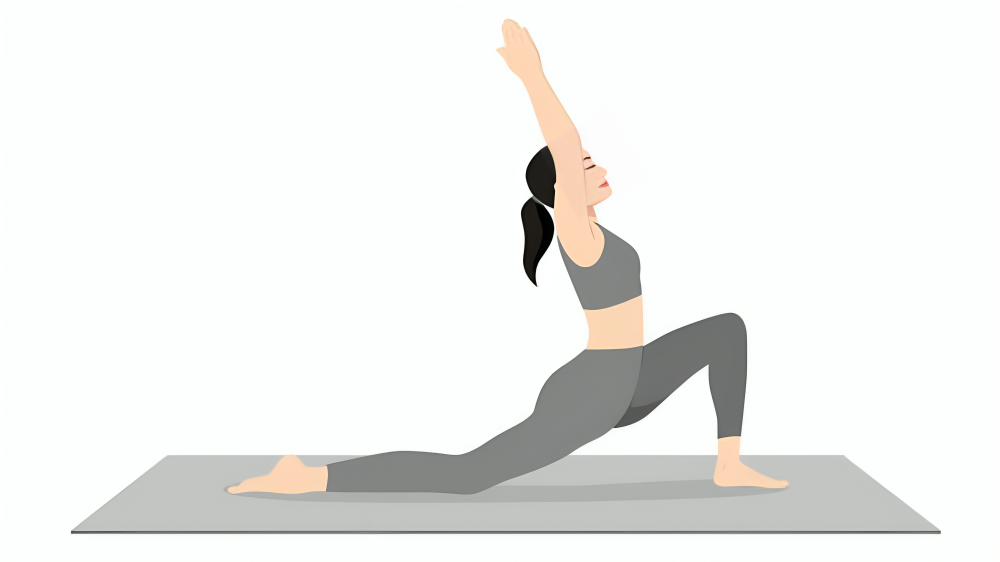
What is Anjaneyasana (Low Lunge Pose)
Anjaneyasana is one of the standing poses of yoga, stretching the leg, hips, chest, and helping balance. It is named after the Hindu god Hanuman (also referred to as Anjaneya), and that god is known for his incredible strength and bravery. In this pose, your front leg makes a 90-degree angle and your back leg extends backward with a deep stretch through the hips and thighs. Anjaneyasana is one of those foundational poses most any level student can grasp.
How to Do an Anjaneyasana
Start in Downward Dog:
Start from the Downward Facing Dog pose. Keep your palms firmly pressed on the mat and lift your hips up high, making a triangle-like figure with your body.
Step Your Right Foot Forward:
Step 3: From Downward Dog, step your right foot forward, placing it between your hands. Your foot has to end directly under your knee, creating a 90-degree angle between your leg and your foot.
Lower Your Left Knee:
Press your left knee down to the ground, then place the top of your left foot on the floor.
Raise Your Torso
As you breathe in, lift your torso and arms up and over your head. Your arms can either be pointing forward and crossing each other above your head, or the palms of your hands should be together behind your head. Your eyes should go forward, or you can slowly inch your chin down to your chest.
Contract Your Abs:
Pull your belly button a little toward your spine to contact your abs and protect your lower back.
Retain the Pose:
Hold the stretch for 5-10 breaths, deepening as you breathe out. You should feel it stretch along your hips and down your thighs, deep into your chest.
Side Switch:
To come out of the pose, bring your hands back to the mat. Step your right foot back into Downward Dog and repeat on the other side.
Benefits of Anjaneyasana
Improves Hip Flexibility: One of the obvious benefits of Anjaneyasana is that it extends and opens up the hip flexors. Many people today have tight hips due to prolonged hours sitting, and this pose helps relieve it.
Strengthen the Lower Body:
You’re contracting your legs and glutes to hold the lunge, making these stronger.
Balancing Pose: 3
Anjaneyasana makes you balance in your body, like when reaching up to the arms-overhead. With practice, you’ll get an overall sense of balancing and coordinating.
Relieve Lower Back Pain:
Anjaneyasana opens the chest and stretches the hip flexors, relieving the compression of the lower back, and an individual suffering from back pain really needs it for sure.
Lifts Lung Capacity:
Lifting your arms and opening the chest in this pose, you would breathe deeper, that may just brighten up your lung capacity and energize your entire body.
Focuses and Ensures Mental Clarity:
Balancing in Anjaneyasana requires full concentration. This will help keep your mind focused and present, which also brings greater mental clarity not just on the mat, but off it as well.
It’s Here Chaturanga Asana How to Do It and what are Benefits
FAQs
Q: Can I do Anjaneyasana as a beginner?
Yes! This is a great asana for beginners. If you are not flexible enough yet, you can always use aids such as blocks or a blanket to help you in this asana.
Q: How long should I hold Anjaneyasana?
You should be able to hold this pose for 5-10 breaths on both sides depending on your comfort level. The longer you can hold the pose the deeper the stretch will feel as you become more experienced in the pose.
Q: Can I do this pose if I have pain in my knees?
If you do get some pain in the knees, be a little careful. You can use a blanket or cushion underneath the back knee for additional support. Or you can ask your yoga teacher to teach you the modifications.

